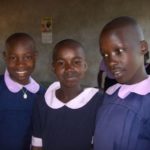
Region: Sub-Saharan Africa
St. Martin de Porres (Nyabondo, KENYA) is a school and rehabilitation center for children with disabilities, many of whom have cerebral palsy. It is the only center that provides these services in all of western Kenya, and because of this, students come from Kenya, Rwanda, Tanzania, and Uganda.
Cerebral palsy is caused by damage to the developing brain’s motor control centers. It can appear during pregnancy, childbirth, or in the first few years of life. While movement disorder, usually referring to the ability the move, and to maintain balance & posture, is the key aspect of cerebral palsy, frequently accompanying symptoms include communication, behavior & sight-based perceptual problems, as well as cognitive & learning disabilities. At the moment, cerebral palsy has no known cure. Nevertheless, the condition can be managed through physio- and occupational therapy. Early intervention can help children lead a normal life.
The St. Martin de Porres School was started in 2006, but became an IPM partner in 2007. The school was built, as a result of the fact that most children with cerebral palsy were being taken to conventional schools, where many of them couldn’t cope with the learning environment and needed special attention. The school has grown to serve many communities. It not only provides basic learning & adaptive skills, as well as walking aids and other needed devices, but also ensures assessment & early identification of cerebral palsy.
During the past year, St. Martin de Porres has served 150 students and has continued to excel in its holistic programming. The school provides primary & secondary education, vocational training in cooking & tailoring, and boarding & caring for students.
It also offers outpatient physical therapy, prosthetics and self-care activities, as many of the children are unable to walk, eat, and stand by themselves, while also enabling monthly orthopedic surgeries. The latter have been conducted in collaboration with a Nairobi-based nonprofit, Amref Health Africa. In the past, IPM supported the school, by funding the food program as well as paying the cooks.
I. Finishing the new student dorms
Through the financial support of a congregation from Finland, St. Martin de Porres was able to finalize the construction of two new large and modern dorm facilities for the students, which will allow the school to house a total of 200 students.
Prior to the construction of the new facilities, the existing ones housed 47 boys sharing 24 bunk beds and two toilets in one dorm room, and 32 girls sharing 24 beds and two toilets in another room, adjacent to the boys’ dormitory.
There was limited space in the dorms, since, due to the children’s physical disabilities, the beds could not be stacked, as a majority of the students would not be able to get up and down from a bunk-bed set-up. The laborer and carpentry work for constructing these dorms was carried out by a majority of deaf and/or physically handicapped adolescents, young adults, and adults.
The school was also able to complete the construction of a pathway enabling students in wheel chairs to move more easily and independently throughout the property.
II. Providing secondary schooling
In response to the scarcity of secondary schools for children with cerebral palsy in Kenya, St. Martin de Porres recently decided to supplement this lacuna, by creating one. While implementing a secondary school program, it is currently struggling, as there are no classrooms for the students, who usually have to set up desks and benches in small corners of the hallways or outdoor areas, no funding for additional teachers, and no laboratory equipment or additional supplies for the classes, which would permit carrying out practical exercises or exams.
III. Enabling artistic endeavors
The school is allowing its students to develop their artistic abilities. In 2013, some of the students took part in a drama festival and excelled at their Scottish Dance interpretation. They are also offered a music program, with most of them being able to recite or sing poems and songs. The students enjoy having access to these types of activities.
IV. Goals & Projections
One of the school short-term goals is to add new bedding for the newly constructing dorms. The school is also looking for funding to cover the physical support products that the students often need, including wheelchairs and rolling walkers, braces and other orthotic devices, and communication aids, such as computers with attached voice synthesizers. This is coupled with maintaining up-to-date medical equipment, including surgery beds, anesthetic medicine, lamps, orthopedic tools, and physical therapy equipment.
The school would like to expand its marketing & outreach skills, in order to raise awareness in local communities about children with physical disabilities, as well as to increase families’ involvement in caring for these children.
On the longer-term, one of the key priorities is to build two classrooms for the secondary school and expand the number of teachers, while also obtaining laboratory equipment for the secondary school students. The school would also like to be able to mobilize resources, so as to construct a dormitory for the teachers, since 19 of them are now living next to the school in a tin ‘hut,’ which undergoes extreme temperatures and gets very hot during the day and extremely cold during the night. The hut lacks electricity and running water.